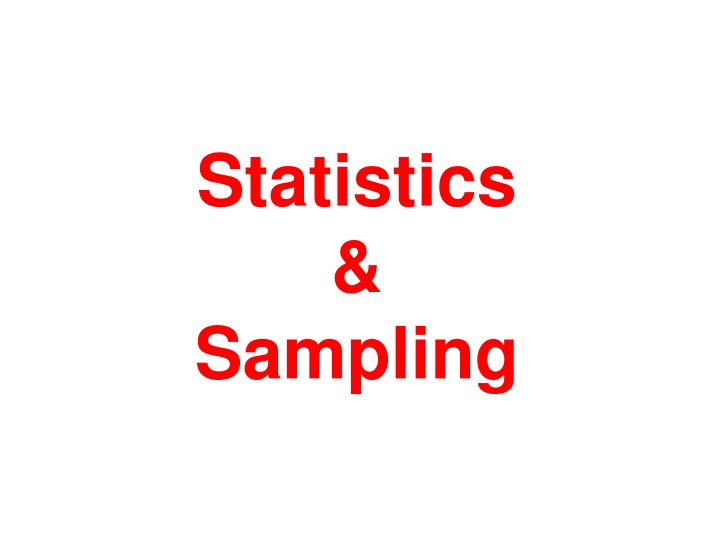
Statistics and Sampling Techniques
Explore descriptive and inferential statistics, learn about central tendency, dispersion, and the importance of statistical significance. Discover the difference between populations and samples, sampling techniques like random and convenience sampling, and types of errors in inferential statistics. Enhance your knowledge on data analysis and research methodologies.
Download Presentation

Please find below an Image/Link to download the presentation.
The content on the website is provided AS IS for your information and personal use only. It may not be sold, licensed, or shared on other websites without obtaining consent from the author. If you encounter any issues during the download, it is possible that the publisher has removed the file from their server.
You are allowed to download the files provided on this website for personal or commercial use, subject to the condition that they are used lawfully. All files are the property of their respective owners.
The content on the website is provided AS IS for your information and personal use only. It may not be sold, licensed, or shared on other websites without obtaining consent from the author.
E N D
Presentation Transcript
Statistics & Sampling
Descriptive Statistics Descriptive Statistics Numbers that characterize the central tendency and dispersion of a data set. Central Tendency Means, Medians, Modes Dispersion Standard Deviation The average extent to which a score departs from the mean
Inferential Statistics Inferential Statistics The process of using samples to draw conclusions ( inferences ) about populations. Statistical Significance An effect (i.e., a trend or a difference-score) that is unlikely to occur just by chance. Researchers often use the 5% rule ; Outcomes that could occur by chance with a probability less than 5% (p<0.05) are deemed statistically significant .
https://en.wikipedia.org/wiki/Statistical_significance#/media/File:NormalDist1.96.pnghttps://en.wikipedia.org/wiki/Statistical_significance#/media/File:NormalDist1.96.png Inferential Statistics Wiki on Statistical Significance https://en.wikipedia.org/wiki/Statistical_significance
Inferential Statistics Type 1 Error False Positive ( False Alarm ) Alpha Level = Probability of a Type 1 error Type 2 Error False Negative ( Miss ) Beta Level = Probability of a Type 2 error
Populations vs Samples Population Every member in a group of interest. Example: All College Students Sample A sub-set of a population. Example: Denison Psychology Students
https://commons.wikimedia.org/wiki/File:Simple_random_sampling.PNGhttps://commons.wikimedia.org/wiki/File:Simple_random_sampling.PNG Populations vs Samples Simple Random Sampling
Sampling Techniques Random Sampling A technique for selecting a subset of a population; each member of the population has an equal chance of being selected. Random Sampling is preferred Convenience Sampling A technique for selecting a subset of a population; members are selected based on practical matters, like availability.
